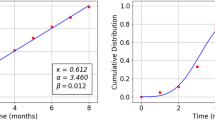Abstract
Several decades ago, Christopher Boorse formulated an influential statistical theory of normative biological functions but it has often been claimed that his theory suffers from insuperable problems such as an inability to handle cases of epidemic and universal diseases. This paper develops a new statistical theory of normative functions that is capable of dealing with the notorious problem of epidemic and universal diseases. The theory is also more detailed than its predecessors and offers other important advantages over them. It is argued here that statistical theories of biological functions should not be so quickly dismissed.
Similar content being viewed by others
Notes
Wakefield (1992) argues that the concept of mental disorder in psychiatry involves a harm component along these lines. The same appears to be the case for disease in medicine.
For ease of exposition, I will just say ‘fitness’ from now on to refer to inclusive fitness.
I will shortly define the normal functional range of a trait as consisting of ±2 standard deviations from the mean of its effects in a reference class. Thirty percent is analogous to the very bottom of the normal functional range in a uniform statistical distribution.
It is also possible that the circumstances for performing a function may not arise within certain generations for a species. In that case, their traits would still have normative functions according to SFT so long as it would have been typical for them to perform the function if those circumstances would have arisen. I am thankful to Karen Neander for prompting me to clarify this point.
Standard deviation in statistics is defined as the square root of the variance of a distribution. It shows how much variation there is from the mean value in the distribution.
Source: de Lau and Breteler (2006).
I assume here that the relationship between quantity of snpc dopaminergic neurons and motor function is linear. This may not be entirely accurate.
This paper draws on material from my doctoral dissertation (Kraemer 2012). I am thankful to Karen Neander and Fred Dretske for useful comments and discussion. I am also thankful to Robert Brandon and Alex Rosenberg for raising interesting challenges to the position that I defend here. Finally, I would like to thank the editor of this journal and an anonymous referee for some very helpful suggestions.
References
Baublys K (1975) Comments on some recent analyses of functional statements in biology. Philos Sci 42(4):469–486
Boorse C (1976) Wright on functions. Philos Rev 85(1):70–86
Boorse C (1977) Health as a theoretical concept. Philos Sci 44(4):542–573
Boorse C (2002) A rebuttal on functions. In: Ariew A, Cummins R, Perlman M (eds) Functions: new essays in the philosophy of psychology and biology. Oxford University Press, New York
Brandon R (1978) Adaptation and evolutionary theory. Stud Hist Philos Sci 9:181–206
Buller D (1998) Etiological theories of function: a geographical survey. Biol Philos 13:505–527
Cummins R (1975) Functional analysis. J Philos 72(20):741–765
Damier P, Hirsch EC, Agid Y, Graybiel AM (1999) The substantia nigra of the human brain II. Patterns of loss of dopamine-containing neurons in Parkinson’s disease. Brain 122:1437–1448
de Lau L, Breteler M (2006) Epidemiology of Parkinson’s disease. Lancet Neurol 5:525–535
Fearnley J, Lees A (1991) Ageing and Parkinson’s disease: substantia nigra regional selectivity. Brain 114:2283–2301
Garson J, Piccinini G (forthcoming) Functions must be performed at appropriate rates in appropriate situations. Brit J Philos Sci
He M, Zeng J, Liu Y, Xu J, Pokharel G, Ellwein L (2004) Refractive error and visual impairment in urban children in Southern China. Invest Ophthalmol Vis Sci 45(3):793–799
Kingma E (2010) Paracetamol, poison, and polio: why Boorse’s account of function fails to distinguish health and disease. Brit J Philos Sci 61:241–264
Kraemer D (2012) Making sense of normative functions and information in neurobiological systems. PhD Dissertation, Duke university, Durham, NC
Lang A, Lozano A (1998) Parkinson’s disease. N Engl J Med 339(15):1044–1053
Logan N, Davies L, Mallen E, Gilmartin B (2005) Ametropia and ocular biometry in a UK university student population. Optom Vis Sci 82(4):261–266
Millikan R (1993) White queen psychology and other essays for Alice. MIT Press, Cambridge
Mills S, Beatty J (1979) The propensity interpretation of fitness. Philos Sci 46(2):263–286
Neander K (1983) Abnormal psychobiology. PhD dissertation. La Trobe University, Victoria, Australia
Neander K (1991) Functions as selected effects: the conceptual analyst’s defense. Philos Sci 58(2):168–184
Neander K (2002) Why history matters: four theories of functions. In: Weingarten M, Schlosser G (eds) Warum Geschichte Zahlt: Vier Theorien von Funktionen. Formen der Erklaerung in der Biologie, Verlag fuer Wissenchaft und Bildung
Roe K, Murphy D (2011) Function, dysfunction and adaptation? In: Adriaens P, De Block A (eds) Maladapting minds: philosophy, psychiatry, and evolutionary theory. Oxford University Press, USA, pp 216–237
Schwartz P (2007) Defining dysfunction: natural selection, design and drawing a line. Philos Sci 74:364–385
Tompkins M, Basgall E, Zamrini E, Hill W (1997) Apoptotic-like changes in Lewy-body-associated disorders and normal aging in substantia nigral neurons. Am J Pathol 150(1):119–131
Wakefield J (1992) The concept of mental disorder: on the boundary between biological facts and social values. Am Psychol 47(3):373–388
Walsh D, Ariew A (1996) A taxonomy of functions. Can J Philos 26(4):493–514
Wimsatt W (1972) Teleology and the logical structure of function statements. Stud Hist Philos Sci 3(1):1–80
Author information
Authors and Affiliations
Corresponding author
Rights and permissions
About this article
Cite this article
Kraemer, D.M. Statistical theories of functions and the problem of epidemic disease. Biol Philos 28, 423–438 (2013). https://doi.org/10.1007/s10539-013-9365-3
Received:
Accepted:
Published:
Issue Date:
DOI: https://doi.org/10.1007/s10539-013-9365-3




